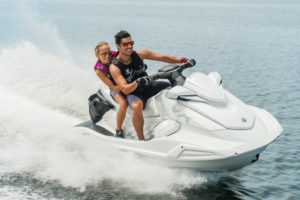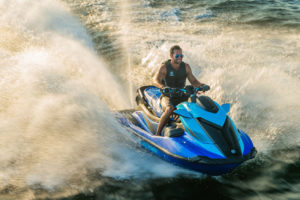Exploring the Styles of PWC & Jet Ski
PWCs come in two main styles, each with its own unique appeal. The first style is the compact runabout, designed for up to two or three riders who sit on top of the watercraft, providing a thrilling riding experience comparable to motorcycling or quadbiking. The second style, the "stand-up" type, is typically tailored for a single occupant who operates the watercraft while standing, enabling tricks, racing, and participation in competitions. Both styles are propelled by an inboard engine driving a pump-jet, equipped with a screw-shaped impeller that generates thrust for propulsion and steering. While most PWCs are designed for two or three people, there are models capable of accommodating up to four passengers. Modern PWCs boast enhanced fuel capacity, allowing for extended cruises, sometimes exceeding 160 kilometres (100 miles).Notable Brands and Origin
Prominent brands in the world of personal watercraft include Kawasaki (Jet Ski), Yamaha (WaveRunner), Bombardier (Sea-Doo), Elaqua (E-PWC), and Honda (AquaTrax). These manufacturers have contributed significantly to the evolution and popularity of PWCs worldwide. The origins of personal watercraft can be traced back to the mid-1950s, with water scooters emerging in the United Kingdom and Europe. Models like the British 200cc propeller-driven Vincent Amanda and the German Wave Roller marked the early stages of PWC development. Over the years, advancements led to the creation of stand-up PWCs, pioneered by Kawasaki in 1972 under the Jet Ski brand, which remains popular to this day.What is the difference between a Jet Ski2 and a PWC?
In the world of personal watercraft, the term "Jet Ski" is often used colloquially to refer to any type of personal watercraft, much like how people commonly use "Hoover" to describe any vacuum cleaner. However, it's essential to clarify that "Jet Ski" is a specific brand name owned by Kawasaki. The more generic term for a personal watercraft is a PWC, which stands for Personal Water Craft. PWCs can be produced by various manufacturers, including Yamaha (WaveRunner), Bombardier (Sea-Doo), and Honda (AquaTrax), each with their unique features and designs. So, while "Jet Ski" is a well-known brand, it's essential to recognize that there are multiple PWC brands, each offering a range of models and experiences on the water.
Racing and Competition Jet Skis
PWC racing has become a prominent sport globally, offering enthusiasts a chance to showcase their skills and passion for speed on the water. Various disciplines, including closed circuit speed races, offshore speed races, endurance races, freestyle, and freeride events, allow participants to compete and entertain spectators. Racing events categorize competitors based on the type of watercraft used, such as saddle jets or stand-up jets. The Aquabike World Championship, established in 1996, is a significant official world series governing PWC racing. Additionally, private competitions like P1 AquaX have gained traction, attracting riders from diverse backgrounds and countries.Beyond Recreation: Practical Uses of PWCs
Personal watercraft serve practical roles beyond recreation. Their compact size, agility, and maneuverability make them invaluable in various scenarios. PWCs are employed by lifeguards for swift water rescues, offering quick response and aid to water users in distress. Furthermore, law enforcement agencies utilize PWCs to enforce regulations in coastal waters, lakes, and rivers, enhancing safety and security. The versatility of PWCs extends to non-recreational applications, including their use by the U.S. Navy as surface targets. Equipped with advanced technology like GPS, electronic compasses, and radar reflectors, PWCs can be controlled remotely and have been utilized for target practice in naval training exercises.Embracing Sustainability: Electric PWCs
In recent years, there has been a growing interest in electric PWCs as a sustainable alternative. As concerns about environmental impact and sustainability escalate, electric watercraft gain traction due to their eco-friendly nature, producing no greenhouse gases and minimizing pollution of waterways. The world of personal watercraft continues to evolve, offering thrills and versatility for both leisure and practical applications. Whether riders seek the rush of racing or the tranquility of a cruise, PWCs provide an exciting way to experience the water, blending technology, speed, and adventure.Yamaha Waverunners in the world of Jet Skis
The Yamaha WaveRunner stands as a beacon in the realm of personal watercraft (PWC), revolutionising the way enthusiasts experience water adventures. Produced by the Yamaha Motor Company, WaveRunner has become synonymous with innovation, excitement, and cutting-edge design in the PWC market.A Trailblazing Invention
The journey of the WaveRunner began in the 1960s when Clayton Jacobson II, an avid American motorcycle enthusiast and banker, conceptualized and crafted the first personal watercraft. This invention laid the foundation for what would eventually become an iconic product in the watercraft industry. In a licensing agreement, Bombardier took up the production and marketing of Jacobson's creation. Later, Kawasaki acquired the license, leading to the birth of the iconic Jet Ski.Yamaha's Venture into the PWC Domain
Yamaha, a company with a rich history in watercraft manufacturing since the 1960s, entered the personal watercraft domain in 1986. That year marked the introduction of the WaveRunner, initially known as the Marine Jet 500T. A breakthrough in the PWC world, the WaveRunner stood out as the first saddle watercraft, an innovation that continues to dominate the market to this day. In subsequent years, Yamaha elevated the WaveRunner's design and features. In 1987, the WaveJammer 500 (Marine Jet 500S) showcased a shift from handlebars mounted on an articulated arm to a fixed handlebar, aligning with the evolution of hand watercraft design. In 1990, Yamaha took a significant leap by launching the WaveRunner III 650 (Marine Jet 650TL), the first PWC to offer a three-person seat and reverse functionality. Simultaneously, they introduced the SuperJet 650, their inaugural personal watercraft model.Yamaha's WaveRunner Series
Over the years, Yamaha has diversified its WaveRunner offerings to cater to a wide range of enthusiasts, from beginners to competitive riders. Presently, Yamaha has produced five distinct series of WaveRunners:- EX Series: Ideal for entry-level riders, combining affordability with exhilarating performance.
- VX Series: Striking a balance between luxury, versatility, and performance, making it a popular choice among riders.
- FX Series: Delivering unparalleled comfort, innovation, and high performance, tailored for seasoned riders seeking adventure.
- Performance Race Series: Engineered for speed and precision, targeting competitive riders craving the thrill of the race.
- SuperJet: Catering to those seeking a stand-up PWC experience, perfect for freestyle and agile maneuvering on the water.


